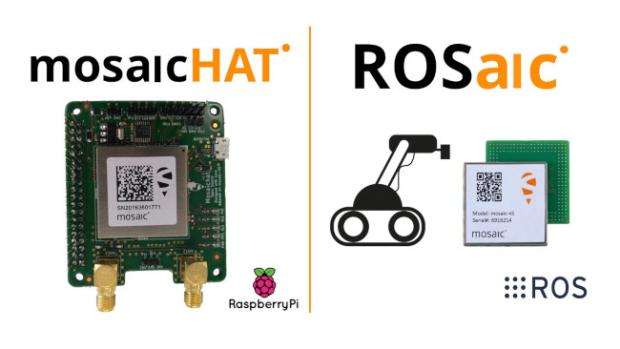Septentrio announces open source software and hardware for autonomous applications with GNSS
Posted on 20-10-2020
Open source software and hardware available for mosaic high-precision GNSS module receiver integration
Leuven, Belgium – October 20, 2020 - Septentrio, a leader in high-precision GNSS* positioning solutions, announces today two important open source resources for its GPS/GNSS module receivers. The first, ROSaic, is a ROS (Robot Operating System) driver for the mosaic-X5 module as well as other Septentrio GNSS receivers. The second project, mosaicHAT, is an open source hardware reference design combining mosaic-X5 with a Raspberry Pi single-board computer. Both projects facilitate integration of centimeter-level reliable positioning into robotic and other machine automation applications.
ROSaic driver operates on ROS, a widely used programming environment within the industry as well as academics, commonly used for integrating robot technology and developing advanced robotics and autonomous systems. ROS allows data from numerous sensors to be combined allowing high levels of autonomy.
The mosaicHAT project facilitates accurate and reliable GNSS positioning for robotics and automation on a hardware level. Numerous engineers today use Raspberry Pi for prototyping and initial integrations. The mosaicHAT board is an easy way for integrators to get started with Septentrio’s mosaic-X5 GNSS module. By plugging mosaicHAT into a compatible Raspberry Pi, users have access to high-accuracy positioning with a high update rate, ideal for machine navigation and control. The small 56x65 mm board exposes basic interfaces such as USB, serial, and general-purpose communication pins. The reference design, footprint and documentation are available for easy board printing or further customization.
"We are excited about both the ROSaic driver and the mosaicHAT being part of the GitHub community and we highly appreciate the initial authors work as well as the future contributors. Both projects are available as open source, thus empowering the community to easily fit autonomous or robotic systems with highly accurate and reliable GNSS positioning technology," notes Gustavo Lopez, Market Access Manager at Septentrio.
The ROSaic driver is available on the ROS wiki page and on the Septentrio GitHub repository while the mosaicHAT can be found on the following GitHub repository. For more information on Septentrio's industry-leading GNSS receivers, please visit www.septentrio.com.
ROS [and/or the "nine dots" ROS logo and/or any other ROS trademark used] is a trademark of Open Robotics. Raspberry Pi is a trademark of the Raspberry Pi organization.
* Global Navigation Satellite System including the American GPS, European Galileo, Russian GLONASS, Chinese BeiDou, Japan’s QZSS and India’s NavIC. These satellite constellations broadcast positioning information to receivers which use it to calculate their absolute position.
----
If reposting this press release, please include a link to the Septentrio web site.
High res image

